Key takeaways
- Landscape photography involves patience and a deep connection with nature, crucial for capturing the essence of a scene.
- Essential gear includes a sturdy tripod, versatile lenses, and a well-organized camera bag for efficient shooting while hiking.
- The best times to shoot in Yosemite are during early morning and late afternoon, when the light enhances the landscape’s mood and depth.
- Edit photos carefully to maintain natural colors, using techniques like graduated filters and fine-tuning noise reduction for clarity.
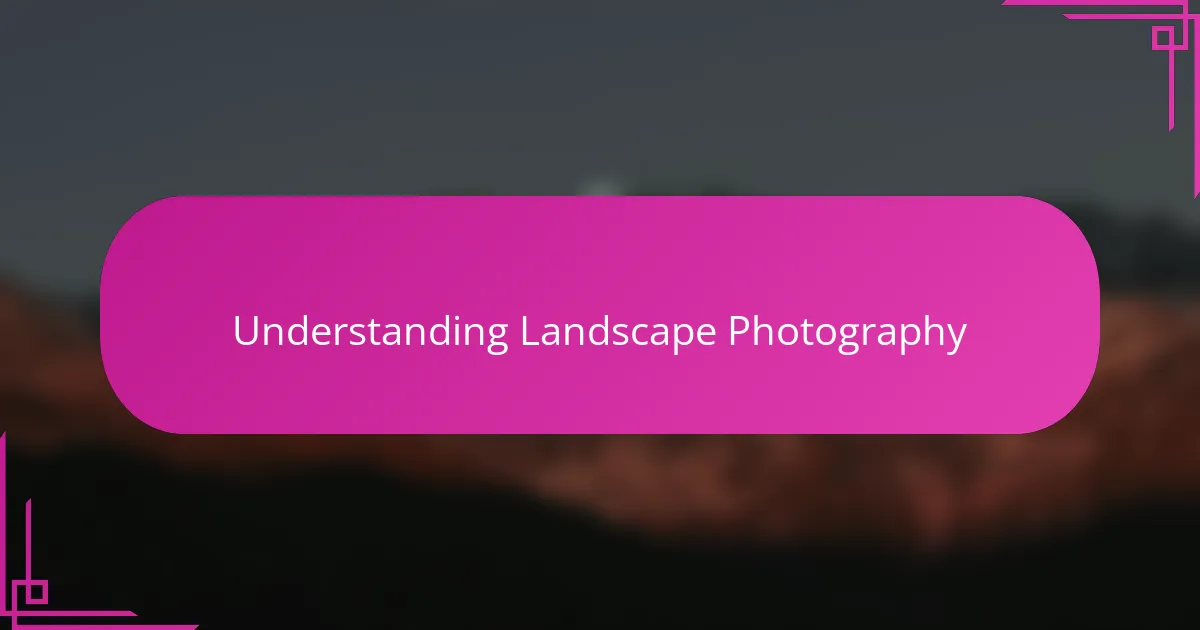
Understanding Landscape Photography
When I first ventured into landscape photography, I quickly realized it’s about more than just pointing a camera at a scene. It’s about understanding light, composition, and the story the landscape tells. Have you ever stood in front of a vast view and wondered how to capture its true essence on camera? That’s the challenge—and the joy—of landscape photography.
One thing I learned early on is that patience is key. Light changes rapidly, especially in natural settings like Yosemite. Sometimes, the best shots come after waiting for the perfect moment when shadows fall just right or when golden light bathes the cliffs. It’s almost like collaborating with nature, anticipating its mood shifts.
I also discovered that effective landscape photography requires a deep connection with the environment. When you truly observe a place—its textures, colors, and atmosphere—you can convey its spirit through your images. Isn’t that what draws us back to these landscapes again and again? To capture more than just a picture, but a feeling.
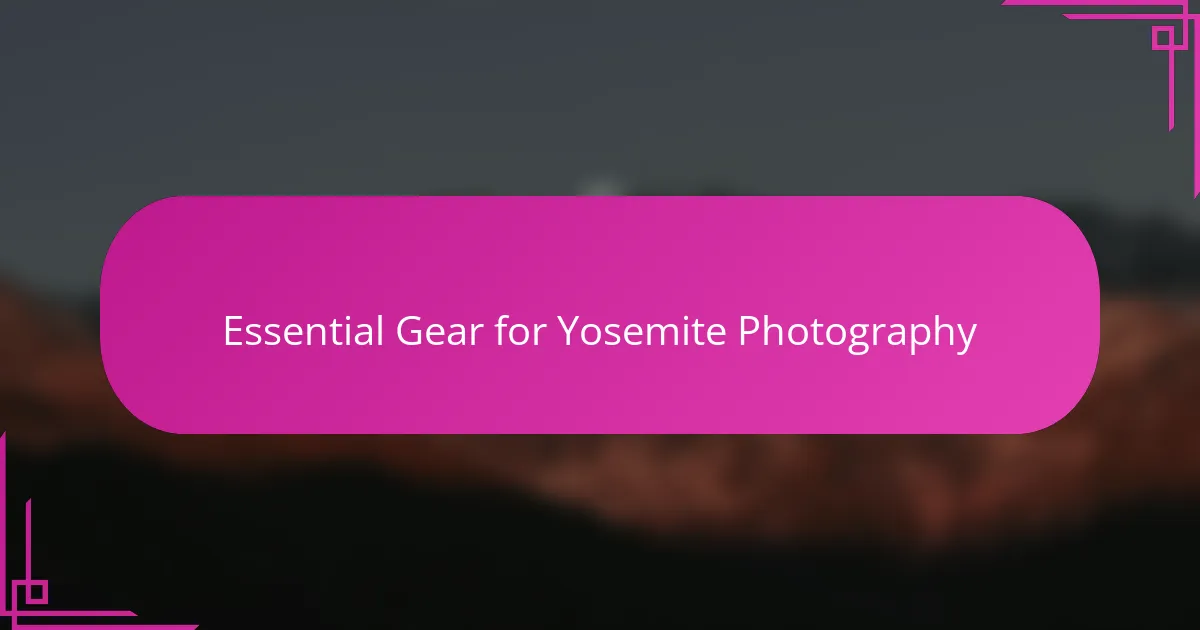
Essential Gear for Yosemite Photography
When I packed my gear for Yosemite, I quickly realized that a sturdy tripod was non-negotiable. The changing light and long exposures needed to capture waterfalls or starry skies simply wouldn’t be possible without stable support. Have you ever tried handheld shots during dim dawn light? The blur is frustrating, and that’s when a tripod becomes your best friend.
Choosing the right lenses also made a huge difference. I tended to carry a wide-angle lens to capture the vastness of Yosemite’s valleys and a telephoto for those intimate details like distant peaks or wildlife. It taught me how versatile your kit needs to be, adapting to both sweeping panoramas and tight compositions.
One piece of gear I underestimated at first was a sturdy camera bag with easy access. Yosemite involves a lot of hiking, and fumbling for gear mid-trail is not just annoying—it can mean missing the perfect light. Having everything organized and ready made me feel more connected to the moment, not just my equipment. Have you found that kind of ease in your own shoots?
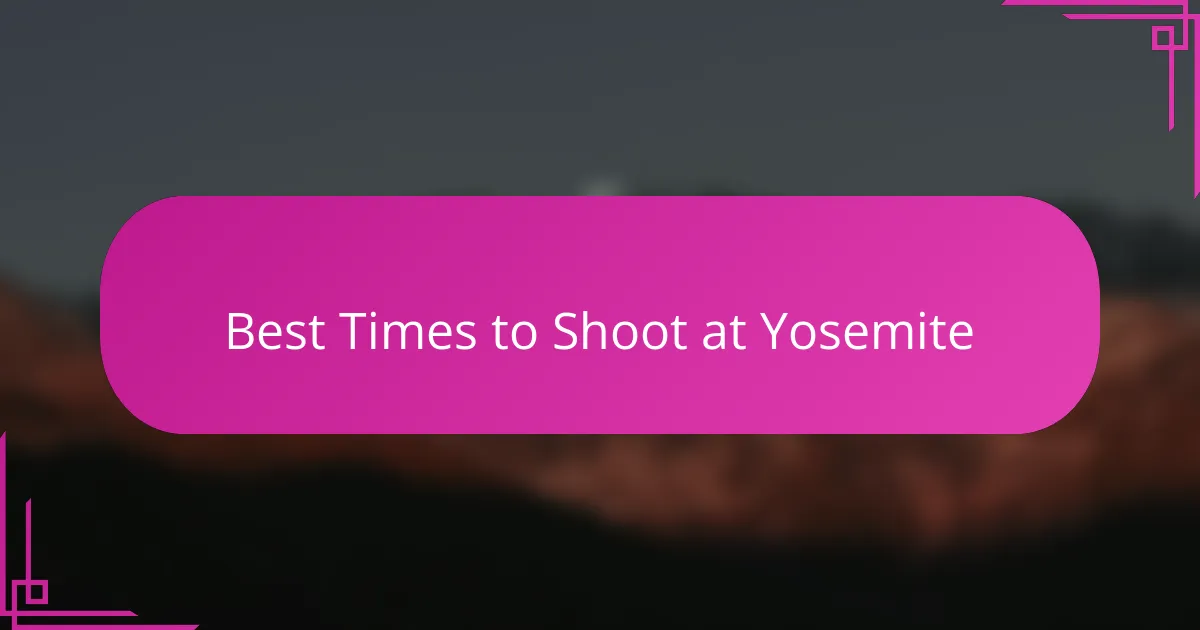
Best Times to Shoot at Yosemite
The best light at Yosemite often greets you early in the morning. I remember waking before dawn, coffee in hand, to catch that soft, golden glow creeping over El Capitan. There’s something magical about those first rays—they feel fresh, crisp, and filled with possibility. Have you ever noticed how morning light can transform even familiar scenes into something unexpectedly beautiful?
Late afternoon and early evening offer another treasure trove of light. I found myself drawn to the warm, rich tones as the sun began to set behind the mountains. Shadows stretch longer, colors deepen, and the air takes on a peaceful stillness that’s perfect for capturing mood. Don’t you find that this time sparks a kind of calm creativity, almost like the landscape is whispering its secrets?
Of course, midday is usually less forgiving, with harsh light that flattens textures and washes out colors. But sometimes, throwing caution to the wind and experimenting under bright conditions can yield striking contrasts or unexpected reflections. Have you ever surprised yourself by finding beauty in what seemed like the worst light? Yosemite’s light has a way of challenging and rewarding patience in equal measure.
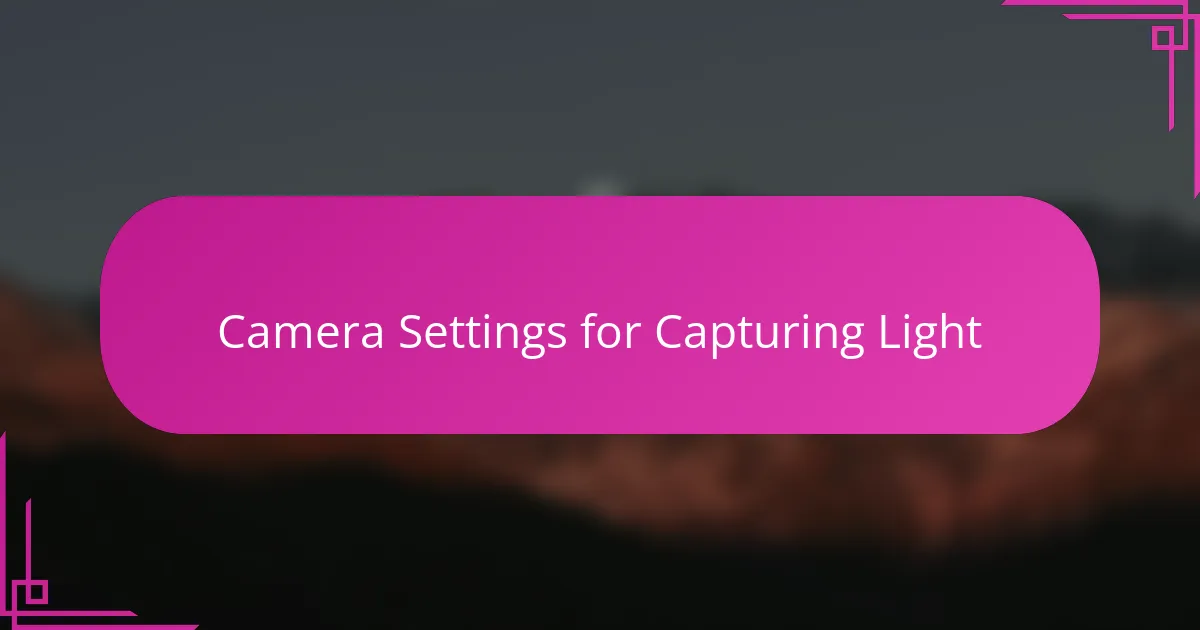
Camera Settings for Capturing Light
When it came to capturing light at Yosemite, selecting the right camera settings felt like tuning an instrument. I often started with a low ISO—around 100 or 200—to keep the image crisp and noise-free, especially during those bright golden hours. Have you noticed how higher ISO can sometimes add unwanted grain that distracts from the scene’s natural beauty?
Aperture was another key player. I found that setting it between f/8 and f/11 struck the perfect balance—allowing enough light while keeping the landscape sharp from front to back. It was fascinating how such a small adjustment could dramatically change the depth and clarity of the image I was trying to create.
Shutter speed was where patience and creativity met. Long exposures, often several seconds, helped me capture the smooth flow of Yosemite’s waterfalls and the subtle movements of clouds. Using my tripod here was essential; without it, those silky effects simply wouldn’t happen. Have you tried holding your camera steady for those dreamy slow captures? It’s a challenge but so worth it.
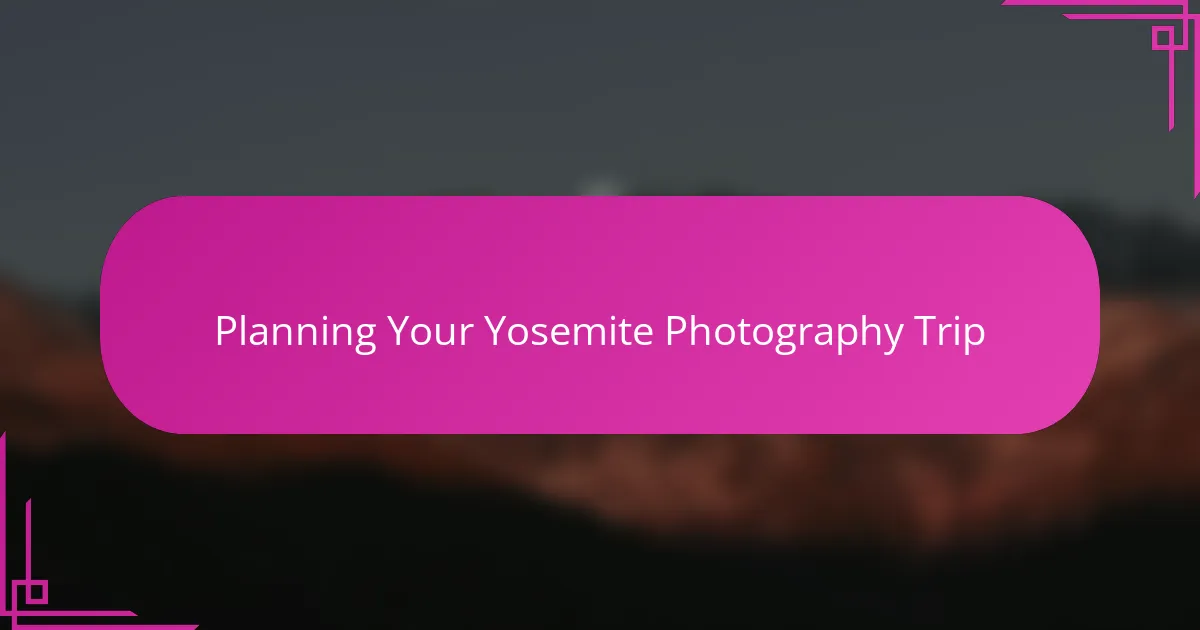
Planning Your Yosemite Photography Trip
Planning your Yosemite photography trip starts well before you load your camera bag. I found that researching the park’s key photo spots and their accessibility helped me map out a realistic daily itinerary. Have you ever arrived somewhere without a plan and felt rushed? Knowing when and where to be gives you space to breathe—and really connect with the scene.
Securing permits and understanding park regulations was something I underestimated at first. Waiting until the last minute can limit your options or add stress, especially during peak seasons. It’s worth checking the Yosemite National Park website in advance. Trust me, a smooth start sets the tone for a successful shoot.
Finally, packing with the weather in mind made all the difference. Yosemite’s climate can be unpredictable—mornings crisp and clear, afternoons suddenly stormy. I always layered up and brought rain protection for both myself and my gear. Being prepared allowed me to stay focused on capturing light, no matter what nature threw my way. Have you had those moments when being ready saved a shoot?
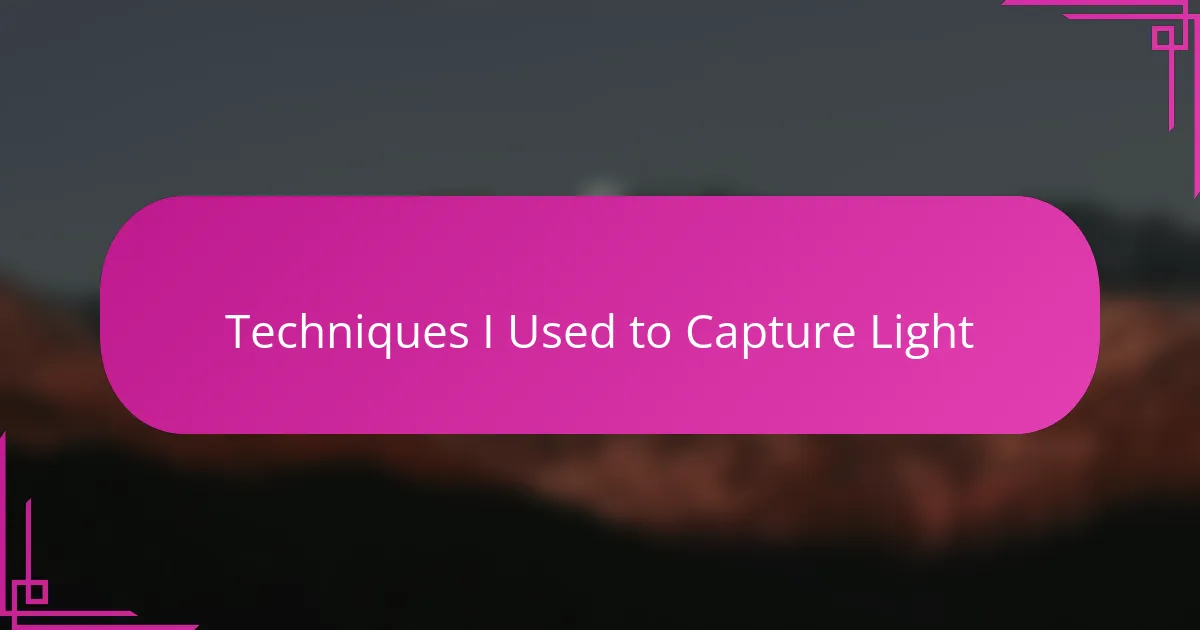
Techniques I Used to Capture Light
One technique I relied on heavily was using reflectors and diffusers to manipulate natural light. At times, Yosemite’s bright sunlight could create harsh shadows, so by softly bouncing light into shadowed areas, I was able to reveal details that would have otherwise been lost. Have you ever tried working with tools that shape light rather than just waiting for it?
I also experimented with bracketing exposures, capturing multiple shots at different light levels to blend later in post-processing. This approach let me preserve the stunning contrast between Yosemite’s glowing highlights and deep shadows. It took some trial and error, but blending those images really helped me recreate the scene’s dynamic range more faithfully.
Finally, I paid close attention to the angle of the sun relative to my subject. Shooting with backlight or side light added depth and texture to rocks and foliage, making the images feel more three-dimensional. Understanding where the light came from made me feel almost like a storyteller—choosing how I wanted to reveal Yosemite’s character through illumination. Have you found that the direction of light can totally change the mood of your photos?
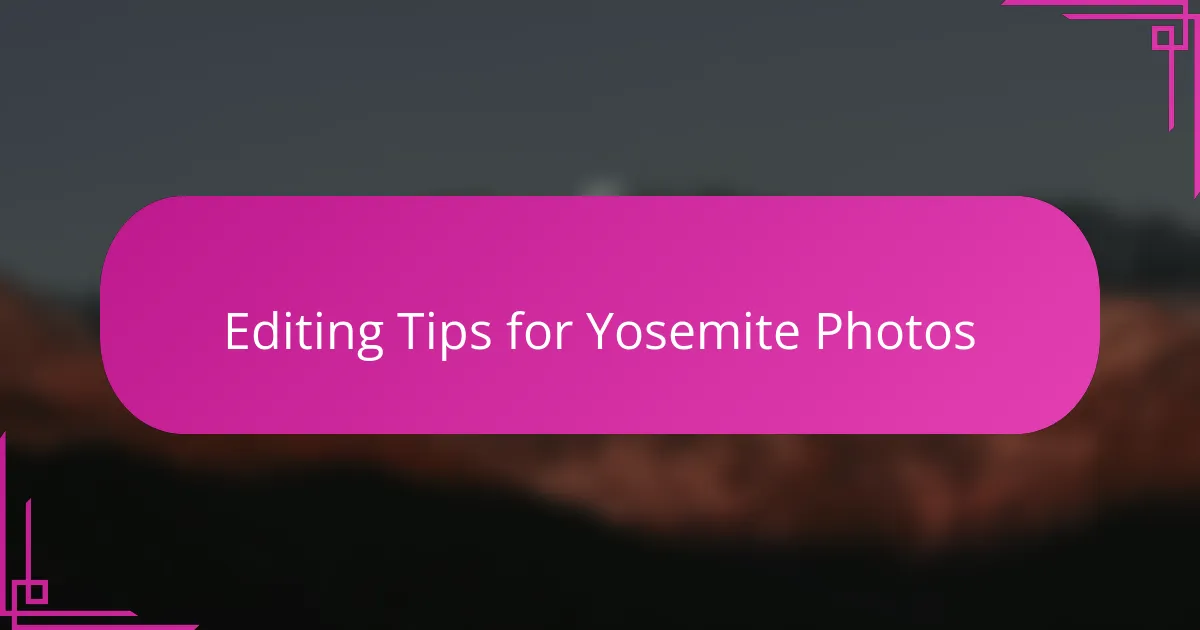
Editing Tips for Yosemite Photos
Editing Yosemite photos taught me the importance of preserving the natural colors and contrasts that make the park so breathtaking. I usually start by boosting vibrance gently—enough to make the greens pop and the granite cliffs glow without making it look artificial. Have you ever felt a photo lost its magic after too much editing? Striking that balance is key.
One tip I swear by is using graduated filters in post-processing to darken the sky just a bit. Yosemite’s skies can be incredibly bright, especially during golden hour, and this subtle adjustment helps bring out cloud details while keeping the rest of the image well-exposed. It’s a little trick I learned after countless tries and failures that really pulls the image together for me.
Lastly, sharpening and noise reduction deserve careful attention. When I shoot in low light, some grain sneaks in, especially around waterfalls or shadowed forests. I treat noise reduction delicately—too much softens the scene, yet too little makes it distracting. Finding that sweet spot enhances the photo’s clarity and preserves the textures that Yosemite’s landscapes are famous for. Do you fine-tune noise settings differently depending on the shot? I find it’s always a bit of a balancing act.